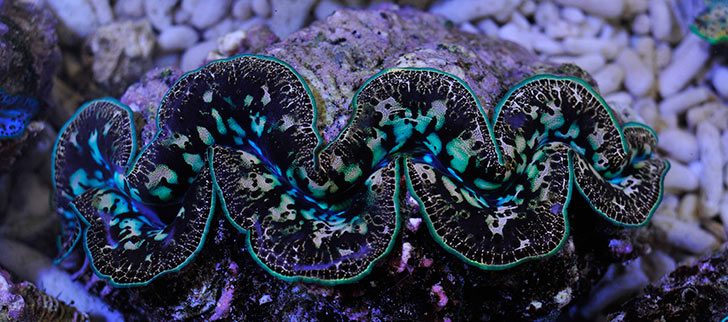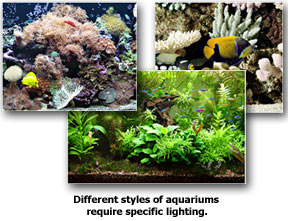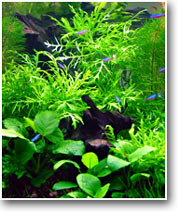
Selecting the Right Light
Technical advances in aquarium lighting have dramatically increased the selection of light fixtures and bulbs available for aquarium hobbyists. Due to this sheer volume, selecting the appropriate bulb and fixture can be both confusing and intimidating. However, by approaching lighting in a systematic fashion, we can address the needs of a particular aquarium system and simplify the decision-making process.
Identifying Use
Aquarium lighting has two main uses: a general aesthetic one and a specific and functional one to sustain the biological processes that occur in the aquarium. While aesthetic use of lighting is important for the aquarist, functional light is absolutely crucial for the well-being of the aquarium inhabitants. By identifying the primary function of lighting for your particular setup, you'll be able to create a dramatic lighting effect or recreate the natural lighting conditions necessary to maintain a healthy aquarium ecosystem.
Aesthetic Purposes
The most common use for aquarium lighting is an aesthetic one, to bring out the vibrant coloration of fish. When we are concerned with the visual quality of light, or how something appears under a particular type of light, we are most interested in the Color Rendering Index (CRI) of a bulb. The CRI of a bulb is based on a scale of 0 to 100, with 100 signifying how an object appears under natural daylight conditions.
Full spectrum bulbs, or bulbs that emit all the wavelengths of visible light, closely approximate the visual effects of natural sunlight and have a high CRI value. However, keep in mind that high CRI value may not necessarily mean the best coloration. Color-enhancing bulbs take advantage of this fact and emit light from the "warmer" (reds to yellows) end of the color spectrum to augment and enrich color. Combining full spectrum bulbs with color-enhancing bulbs is a great way to bring out the best coloration while maintaining a "natural" appearance to the aquarium and its inhabitants.
 The color temperature of a bulb is another aspect to consider when selecting a bulb for its visual quality. Many aquarium bulbs are categorized by their color temperature, signified by their Kelvin rating (K-rating), to give us insight to the appearance of the light emitted by the bulb. The K-rating of a bulb describes the temperature (in degrees Kelvin) and the corresponding color, a theoretical "blackbody," radiates when heated at that same temperature.
The color temperature of a bulb is another aspect to consider when selecting a bulb for its visual quality. Many aquarium bulbs are categorized by their color temperature, signified by their Kelvin rating (K-rating), to give us insight to the appearance of the light emitted by the bulb. The K-rating of a bulb describes the temperature (in degrees Kelvin) and the corresponding color, a theoretical "blackbody," radiates when heated at that same temperature.
The progression of the radiating color follows the color spectrum, from red, orange, yellow, green, blue, indigo, and finally violet as the temperature increases. For example, at 0°K (equivalent to -273° Celsius), a piece of steel or any other blackbody emits no light. As the temperature increases, it begins to emit a red light and continues along the color spectrum as the temperature increases. In other words, bulbs with lower K-ratings tend to produce light that appear "warmer" such as reds, yellows, and oranges and bulbs with high K-ratings produce light that appears "cool." Sunlight at noon has a K-rating of 5,500°K and contains a blend of all the colors of the color spectrum. For this reason, a 5,500°K bulb is referred to as a full-spectrum bulb and can be used as a reference point when selecting a bulb based on its K-rating.
Functional Purposes
Aquarium lighting serves a crucial function of providing vital energy necessary for photosynthesis. As the primary light source (and in most cases, the only light source), proper aquarium lighting is essential for any system that contains photosynthetic organisms such as
plants,
anemones, and corals. When we are concerned with lighting conditions necessary to sustain life, we are most interested in the intensity of the bulb.
Though many factors such as water depth, water clarity, and height/location of the light fixture affect light intensity, the total wattage of a light fixture serves as a general guide when selecting light fixtures. In general, fixtures that utilize higher wattage bulbs will have greater light intensity. Therefore, aquariums that require high lighting conditions will need light fixtures with higher wattage output.
 A good basic rule to follow is to provide 1 to 2 watts of lighting per gallon for fish-only aquariums, 2 to 5 watts per gallon for freshwater planted aquariums, and 4 to 8 watts per gallon for reef aquariums. To calculate the number of watts per gallon an aquarium receives from a light fixture, simply divide the total wattage of the light fixture by the number of gallons of the aquarium. For example, a 55-watt fixture used over a 29-gallon aquarium will provide its inhabitants with slightly less than 2 watts of light per gallon. While this amount of light is perfect for fish-only aquariums, it may not be adequate for most photosynthetic reef inhabitants. Keep in mind that these lighting requirements will vary depending on the species you are keeping and the depth of your tank. It is essential to research the specific lighting requirements of each species.
A good basic rule to follow is to provide 1 to 2 watts of lighting per gallon for fish-only aquariums, 2 to 5 watts per gallon for freshwater planted aquariums, and 4 to 8 watts per gallon for reef aquariums. To calculate the number of watts per gallon an aquarium receives from a light fixture, simply divide the total wattage of the light fixture by the number of gallons of the aquarium. For example, a 55-watt fixture used over a 29-gallon aquarium will provide its inhabitants with slightly less than 2 watts of light per gallon. While this amount of light is perfect for fish-only aquariums, it may not be adequate for most photosynthetic reef inhabitants. Keep in mind that these lighting requirements will vary depending on the species you are keeping and the depth of your tank. It is essential to research the specific lighting requirements of each species.
Selecting the appropriate bulbs and light fixture may seem confusing at first, but by properly identifying your lighting needs as well as the lighting requirements of your aquarium inhabitants, you'll be able to narrow your choices. A carefully selected light fixture will provide you with years of use and a healthy successful aquarium.
|